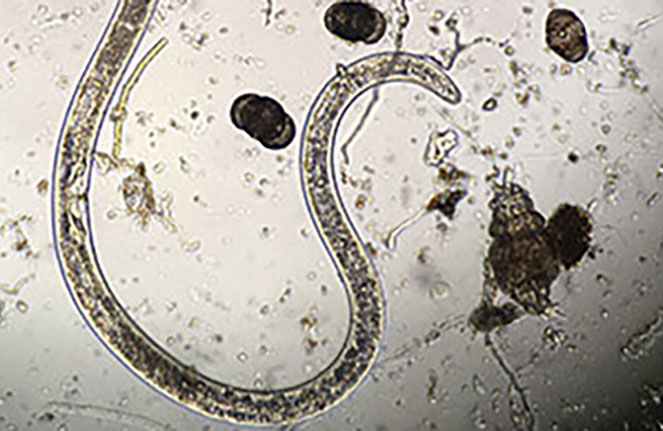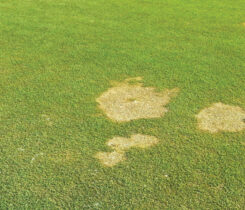Sting nematode distribution in putting green root zones

Adult female sting nematode (Photo: Bruce Martin)
Sting nematodes are very destructive microscopic pests that feed on turfgrass roots. There are limitations to chemical control strategies for managing sting nematodes. Chemicals are only effective if they come in contact with the nematodes. At North Carolina State University, Jim Kerns, Ph.D., and his graduate student Glen Galle observed sting nematodes’ annual behavior to improve chemical application timing.
The scientists determined the vertical distribution of nematodes in greens throughout the year. They conducted golf course trials on L-93 creeping bentgrass and Champion bermudagrass greens. Sting nematodes reach their highest numbers in late summer on both grass species (see Figure 1), but differences in nematode population growth vary among the grass species. Sting nematodes started to increase in March or April on creeping bentgrass. On bermudagrass putting greens, they increased in late April and May. So, chemical application timing is dependent on the putting green turfgrass species used.

Figure 1 Turfgrass researchers at North Carolina State University study the distribution of sting nematodes in bermudagrass and creeping bentgrass rootzones.
An unanticipated result is nematode location in bentgrass greens for 2015. They were in the top 4 inches of the soil in the spring and the middle 4 inches during the summer. A similar trend occurred in 2016, although nematodes were throughout the 12-inch root zone during the summer. In the summer, bermudagrass had an even distribution of nematodes throughout the 12-inch root zone. The presence of nematodes is beyond the typical rooting depth of both turfgrasses.
In both turfgrass species, the winter months show most of the nematodes in the soil’s top 4 inches. This indicates that feeding may be occurring on both grass species. During winter, bermudagrass is dormant, and bentgrass is slow to produce new roots. A fall nematicide application could further protect vulnerable turfgrass roots from nematode feeding.
Reference
Galle, Glenn, and Jim Kerns. 2017. Comparative control methodology of Belonalaimus longicaudatus and Meloidogyne species on golf course putting greens. USGA Green Section Turfgrass and Environmental Research Program: 2017 Research Summaries. p. 265-268. http://archive.lib.msu.edu/tic/ressum/2017/265.pdf












